The 44 climbs of the Giro d'Italia 2021
High mountains pepper three weeks of the Italian Grand Tour
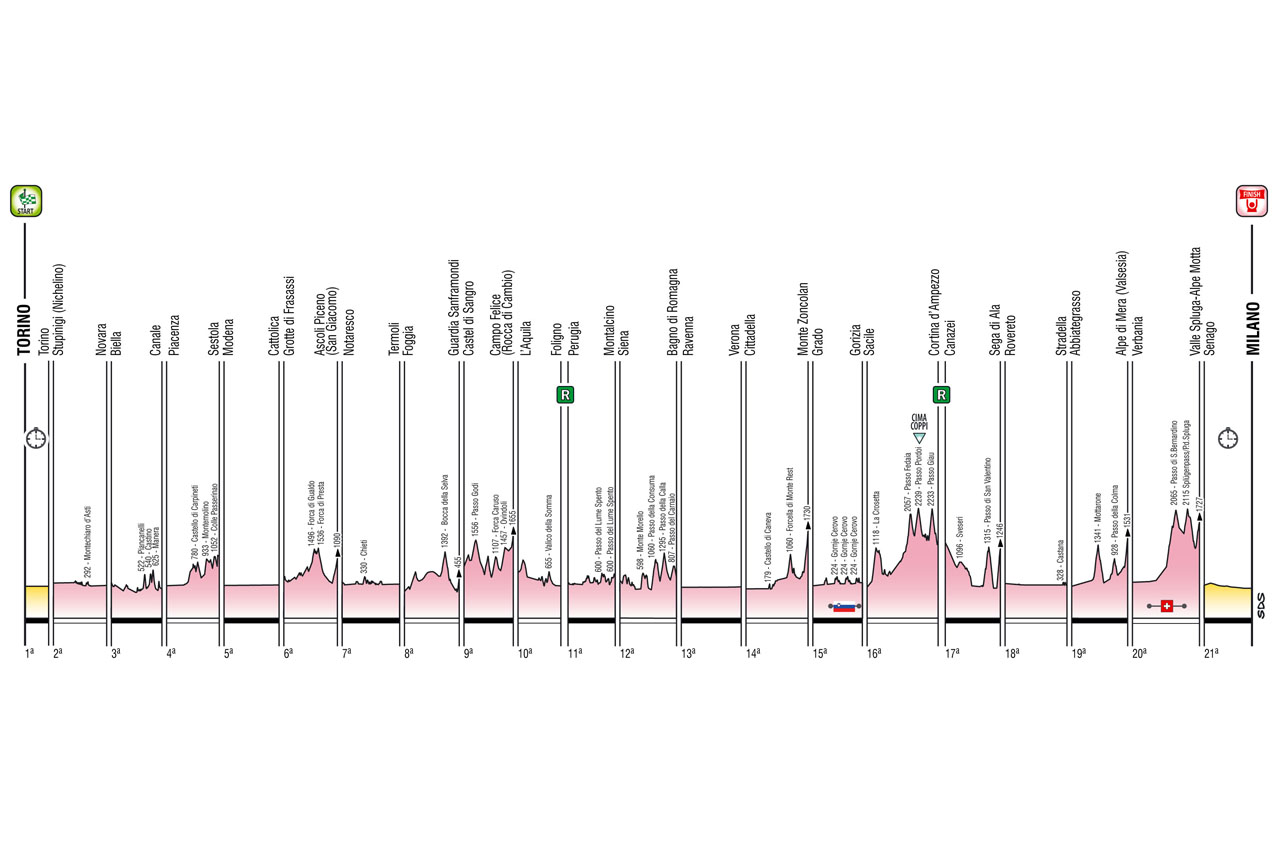
The riders competing in the 2021 Giro d'Italia will face over 47,000 metres of climbing over three weeks of racing - for those who are fans of Everesting, that's more than five times the height of Mount Everest - in other words, a lot of riding uphill. Cyclingnews breaks down the facts and figures of the mountains of the 2021 Giro d'Italia.
Organisers of the Giro d'Italia classify the climbs on a scale of categories 1 to 4, with four being the easiest. The categories are assigned by the difficulty of the climb as well as its position on the stage. In addition to providing the overall pink jersey contenders a chance to distance their rivals, the climbs are also key to the mountains classification - the leader of which wears the maglia azzurra, a fine blue jersey like the one that Ruben Guerreiro (EF Education) won last year.
There are a total of 44 classified mountains in the 2021 Giro d'Italia, 13 of which are the highest category (cat. 1) including the Cima Coppi, or the highest point of the Giro, the Passo Pordoi on stage 16. There are 31 lesser mountains: nine climbs are second category, with 11 each of category 3 and category 4 ascents.
With seven summit finishes in the 2021 Giro d'Italia, three coming in the final week, the mountains are sure to make the magic happen in the race.
| Stage | Climb | Category | km to go | Stage distance |
|---|---|---|---|---|
| 2 | Montechiaro d'Asti | 4 | 83.8 | 179 |
| 3 | Piancanelli | 3 | 67.8 | 190 |
| 3 | Castino | 4 | 45.5 | 190 |
| 3 | Manera | 4 | 36.2 | 190 |
| 4 | Castello di Carpineti | 3 | 75.2 | 187 |
| 4 | Montemolino | 3 | 43.6 | 187 |
| 4 | Colle Passerino | 2 | 2.5 | 187 |
| 6 | Forca di Gualdo | 2 | 71.9 | 160 |
| 6 | Forca di Presta | 3 | 59.6 | 160 |
| 6 | Ascoli Piceno | 2 | 0 | 160 |
| 7 | Chieti | 4 | 118.7 | 181 |
| 8 | Bocca della Selva | 2 | 49.8 | 170 |
| 8 | Guardia Sanframondi | 4 | 0 | 170 |
| 9 | Passo Godi | 2 | 122.4 | 158 |
| 9 | Forca Caruso | 3 | 55.9 | 158 |
| 9 | Ovindoli | 2 | 23 | 158 |
| 9 | Campo Felice | 1 | 0 | 158 |
| 10 | Valco della Somma | 4 | 38.7 | 139 |
| 11 | Passo del Lume Spento* | 3 | 37.4 | 162 |
| 11 | Passodel Lume Spento | 3 | 3.8 | 162 |
| 12 | Monte Morello | 3 | 127 | 212 |
| 12 | Passo della Consuma | 2 | 79.4 | 212 |
| 12 | Passo della Calla | 2 | 48.1 | 212 |
| 12 | Passo del Carnaio | 3 | 9.4 | 212 |
| 14 | Castello di Caneva | 4 | 128.1 | 205 |
| 14 | Forcella Monte Rest | 2 | 58.1 | 205 |
| 14 | Monte Zoncolan | 1 | 0 | 205 |
| 15 | Gornje Cerovo | 4 | 79.4 | 147 |
| 15 | Gornje Cerovo | 4 | 47.9 | 147 |
| 15 | Gornje Cerovo | 4 | 3 | 147 |
| 16 | La Crosetta | 1 | 186.7 | 212 |
| 16 | Passo Fedaia | 1 | 83.9 | 212 |
| 16 | Passo Pordoi | Cima Coppi | 58.8 | 212 |
| 16 | Passo Giau | 1 | 17.5 | 212 |
| 17 | Sveseri | 3 | 135.1 | 193 |
| 17 | Passo di San Valentino | 1 | 37.8 | 193 |
| 17 | Sega di Ala | 1 | 0 | 193 |
| 18 | Castana | 4 | 22.4 | 231 |
| 19 | Mottarone | 1 | 90.9 | 176 |
| 19 | Passo della Colma | 3 | 38.6 | 176 |
| 19 | Alpe di Mera | 1 | 0 | 176 |
| 20 | Passo san Bernardino | 1 | 57.8 | 164 |
| 20 | Passo della Spluga | 1 | 29.1 | 164 |
| 20 | Alpe Motta | 1 | 0 | 164 |
Colle Passerino, Forca di Gualdo and San Giacomo
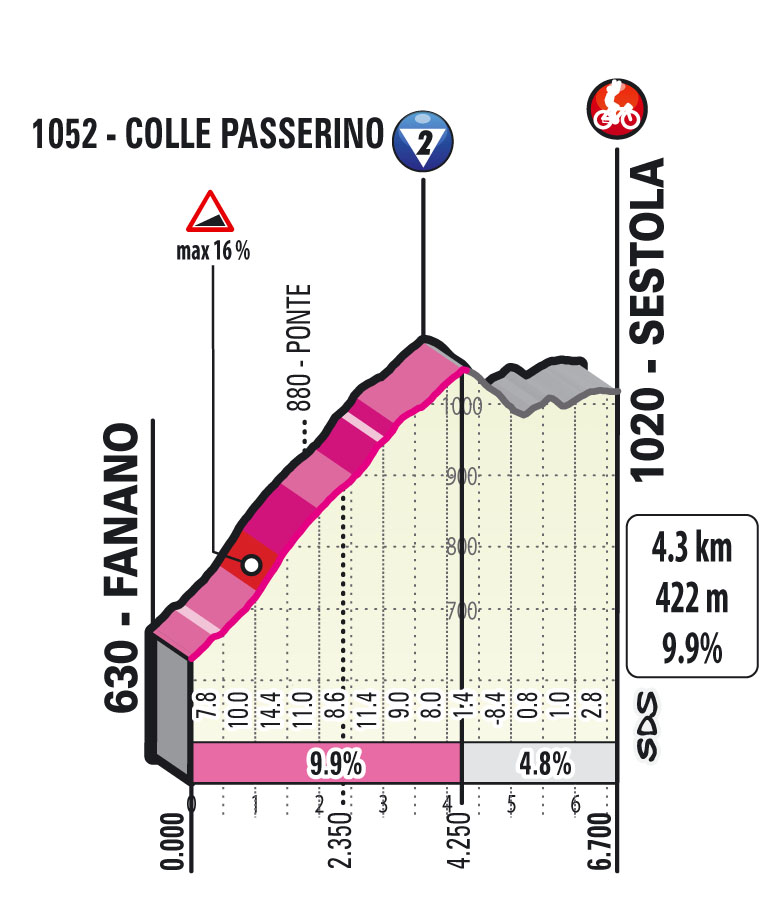
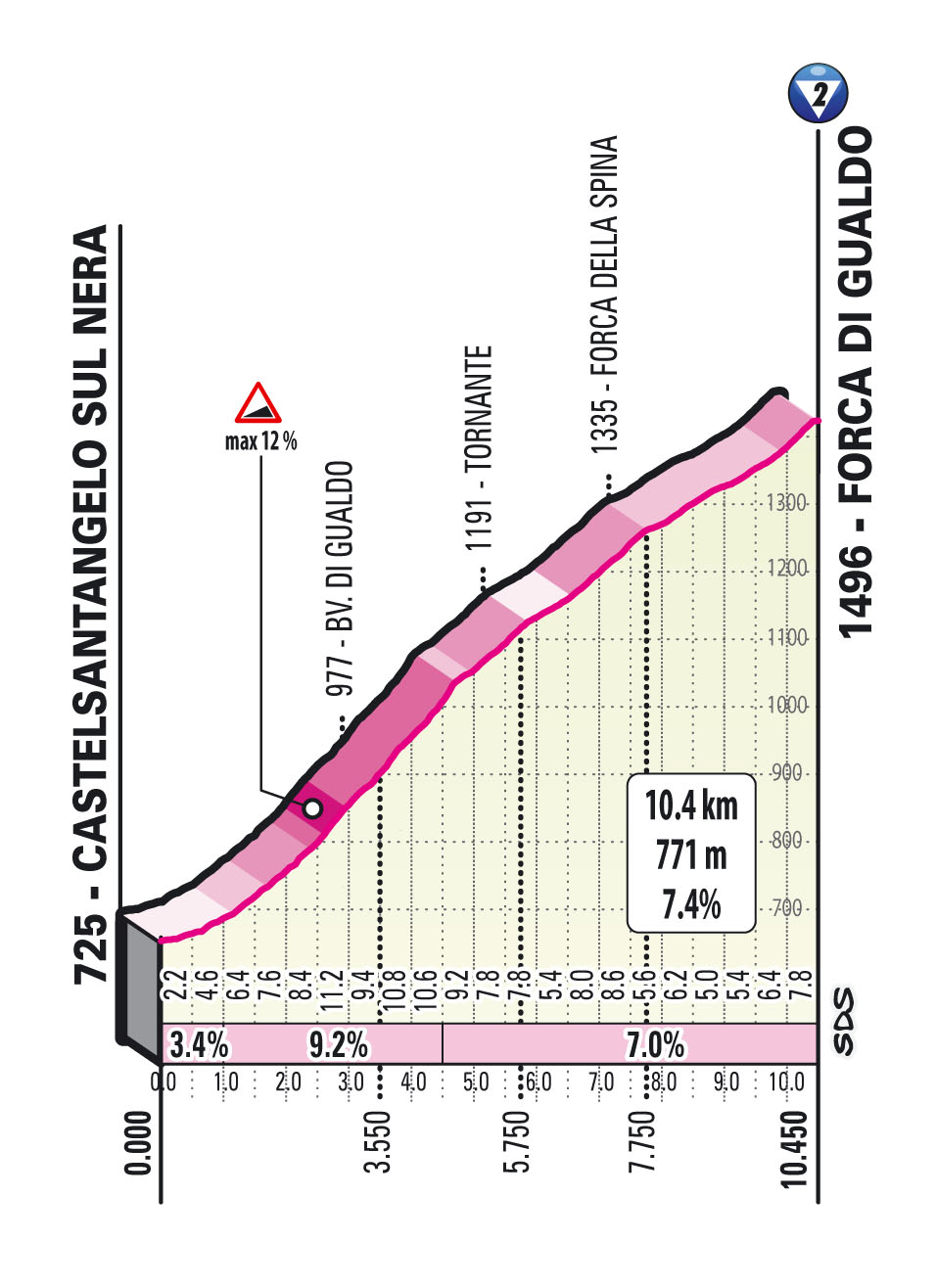
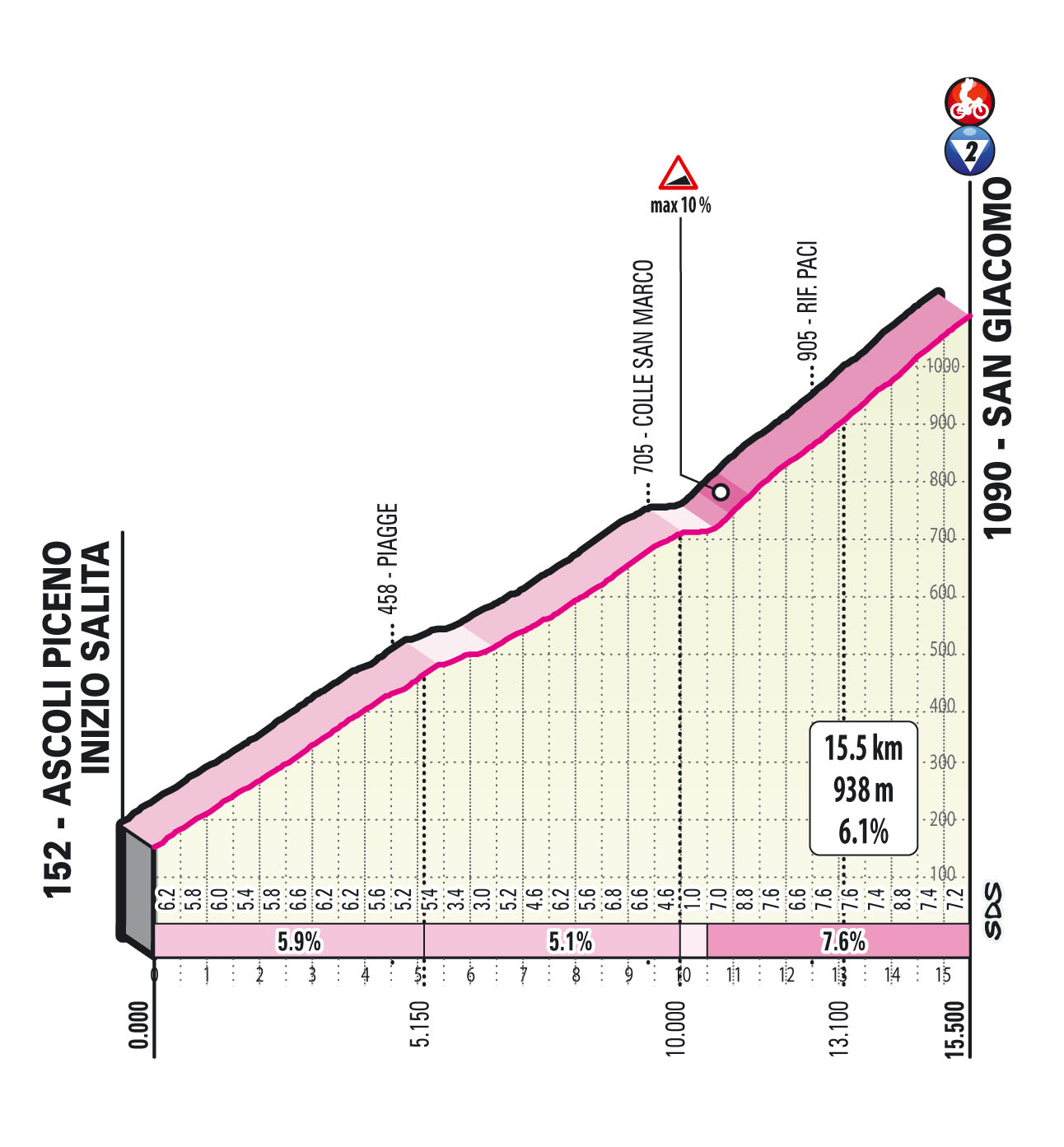
Stage 2, first mountains jersey: The Giro d'Italia opens with a flat individual time trial in Turin and the first climbs come on Sunday, May 9 on stage 2 with a single category 4 ascent at Montechiaro d'Asti awarding the first blue jersey of the race.
Stage 4, first almost-summit finish: Hints of who has form and who doesn't will begin to show early in the first week, with the category 2 Colle Passerino cresting with 2.5km to go on stage 4 on Tuesday, May 11.
The Passerino averages a painful 9.9 per cent with an extended section of double-digit gradients maxing out at 16 per cent. It's only 4.25km long and the stage finishes with a short descent before ending on a plateau. It's a real leg-breaker and comes after 184.5km of racing with two category 3 climbs earlier in the stage.
The latest race content, interviews, features, reviews and expert buying guides, direct to your inbox!
Stage 6, first summit finale: Coming midway through stage 6 on Thursday, May 13, the Forca di Gualdo will be the next major eye-opener for the climbers. At 10.4km, the Forca di Gualdo has extended pitches over 10 per cent with a maximum of 12 per cent. It might ease up in the second half but the climb kicks up again over the top, making for a great attack point.
The overall contenders will have a prime opportunity to test each other on first official summit finish, which comes on stage 6 to the top of the San Giacomo - a massive 15.5km climb that averages 6.1 per cent gradients. It has a section with 5.5km to go that pitches up to 10 per cent and then stays at a 7.6 per cent average to the line, making it an important first-week test.
Sneaky Sanframondi and Campo Felice
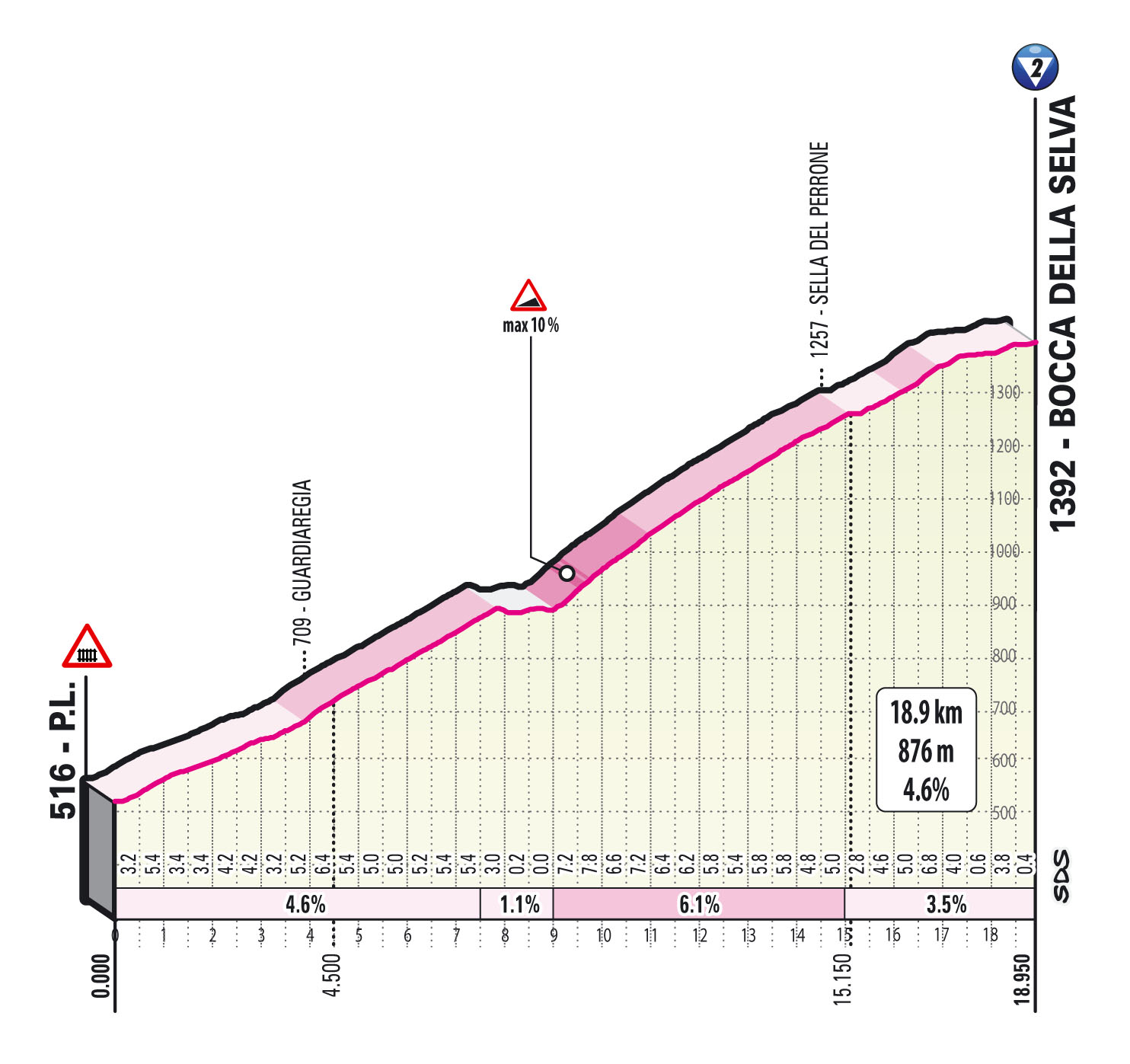
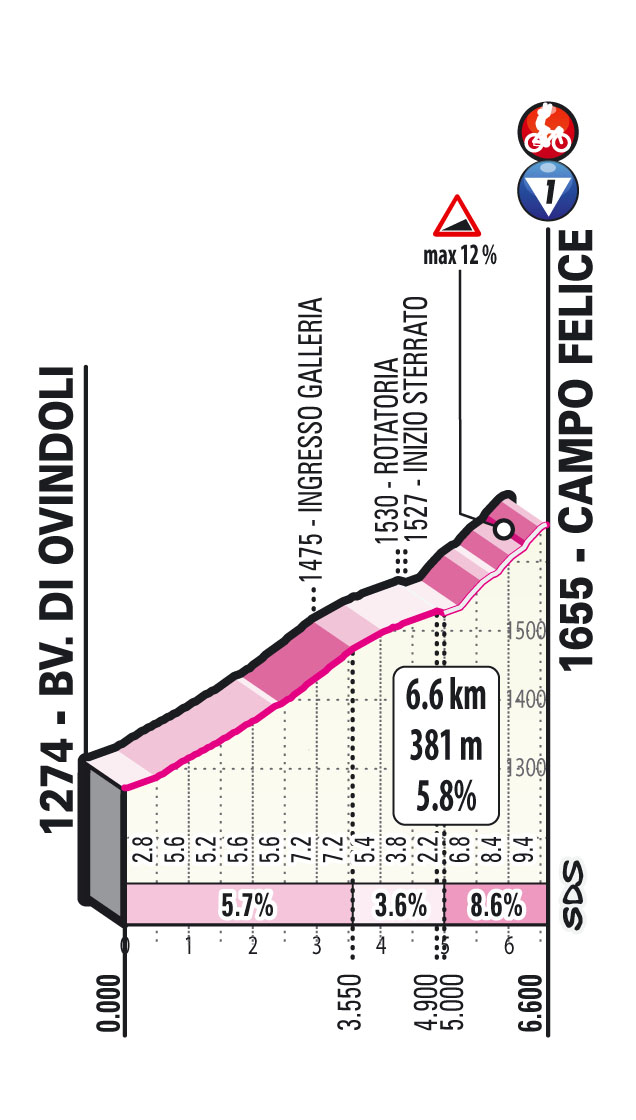
Stage 8 ends in a kicker: Stages 8 and 9 will have the riders begging for the first rest day. The 170km stage on Saturday, May 15, from Foggia sends riders over the 1,392m Bocca della Selva - which tops out with 49.8km to go. It's 18.9km long but not overly steep, although there is a launching pad of 10 per cent at the midpoint that might favour an attacker. The real kicker on the stage is the category 4 finishing ascent. Don't let the rank fool you, though - the 5km climb in Guardia Sanframondi starts gently but ends with a wall that pitches up to over 20 per cent in the final kilometre.
Stage 9 gravel summit: Stage 9 on Sunday won't provide any recovery for legs left shattered by those mountains. Packed into 158 kilometres, the stage heads over the 1,556m Passo Godi, an uncategorized climb en route to the Forca Caruso (cat. 3), before climbing the category 2 Ovindoli, undulating along the plateau before pitching up the Campo Felice. For added fun, the top of the climb is on gravel at 1,655m and at gradients of up to 12 per cent.
No rest in week 2 with Monte Zoncolan and Passo Pordoi
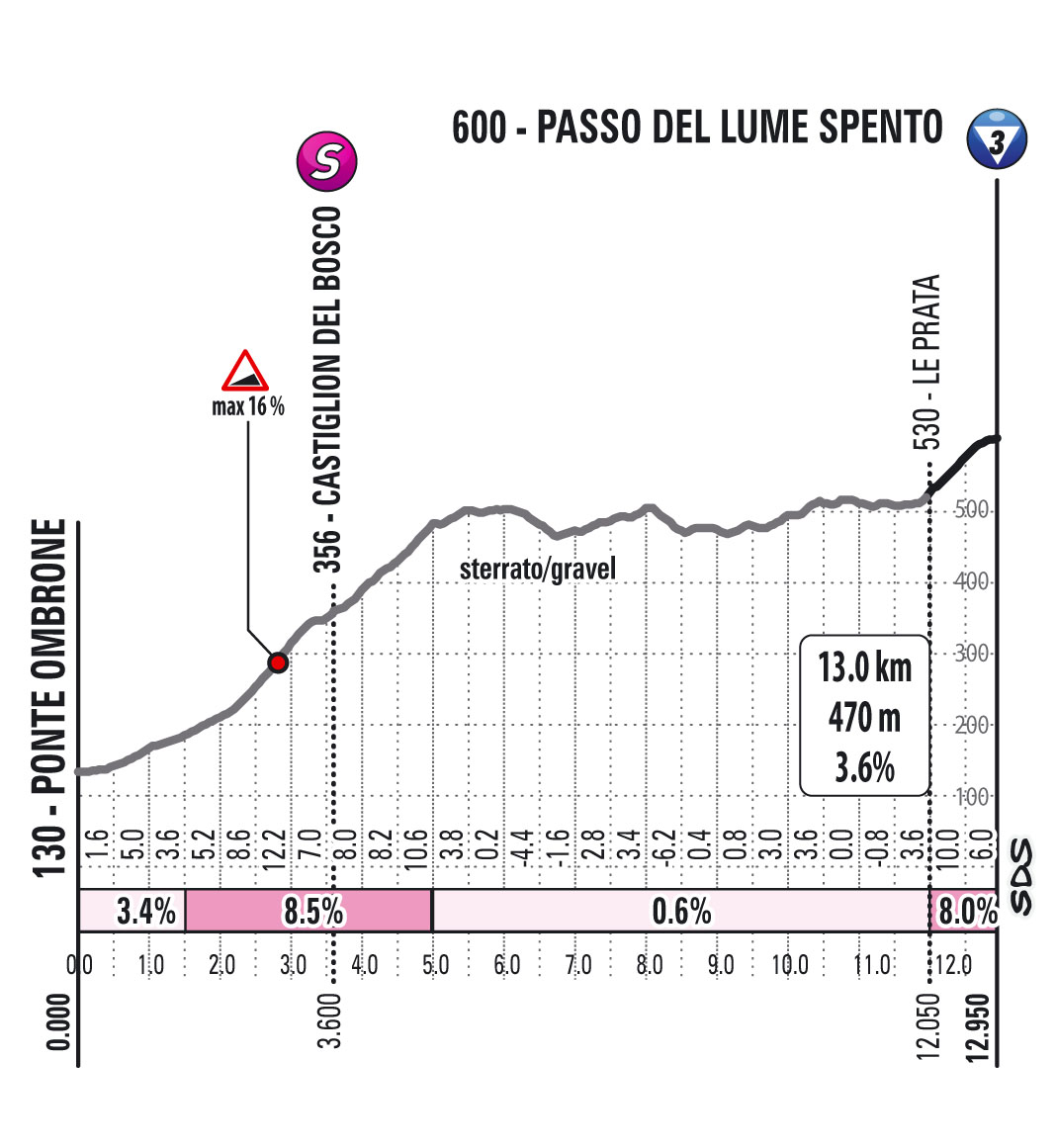
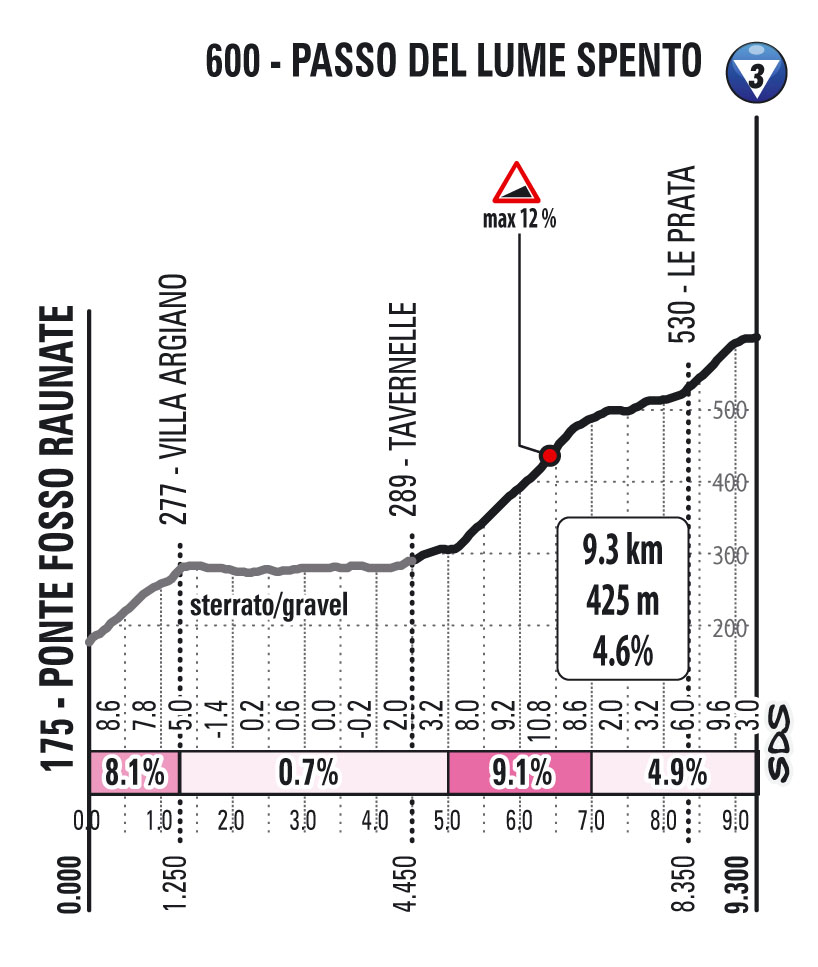
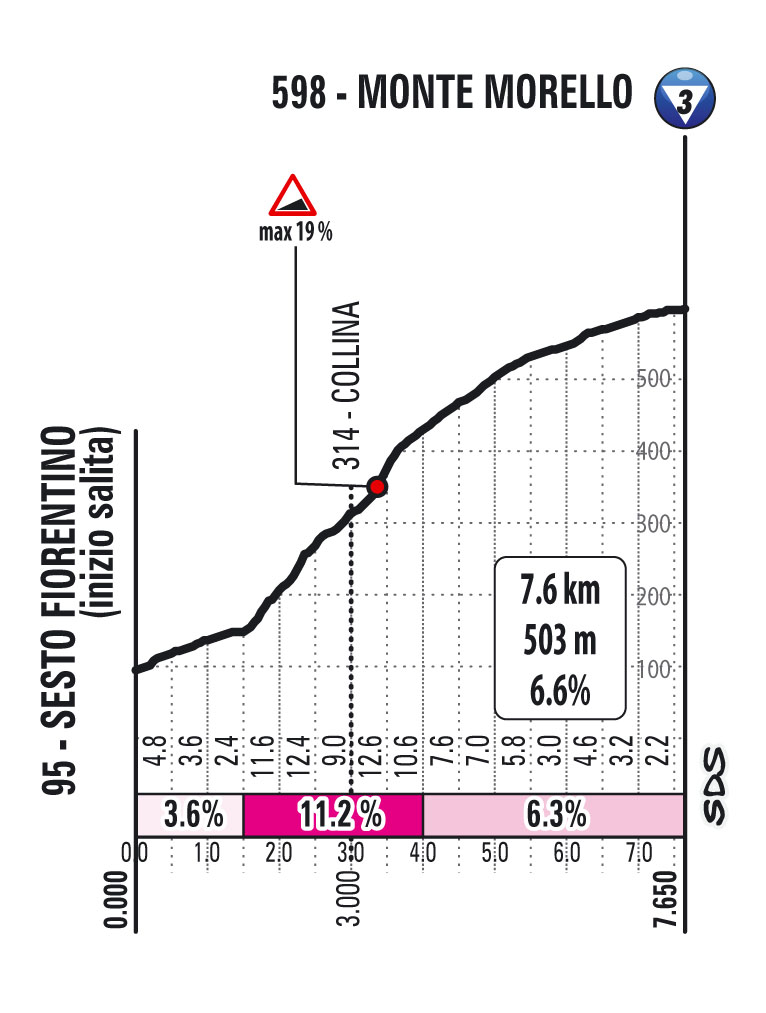
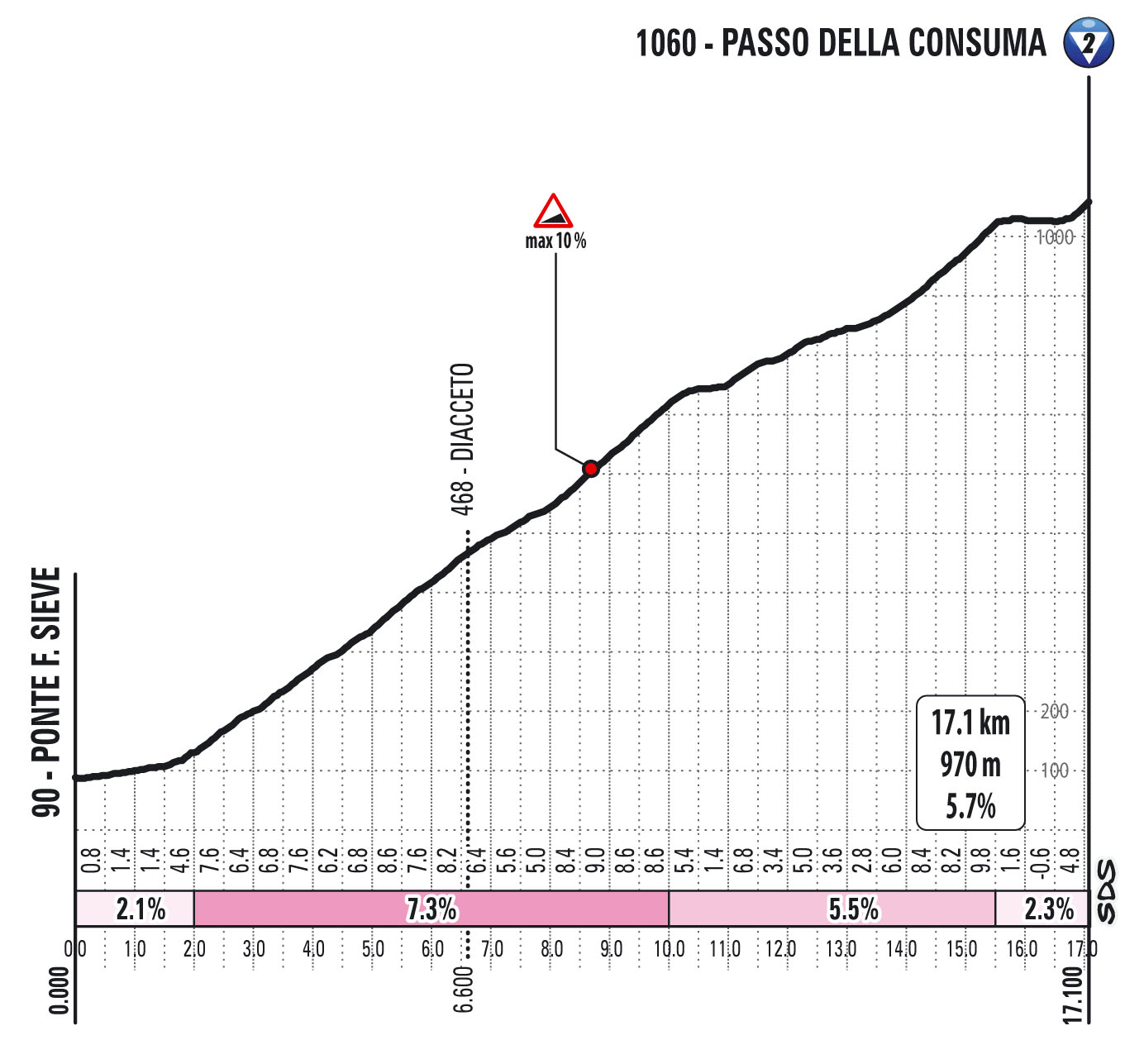
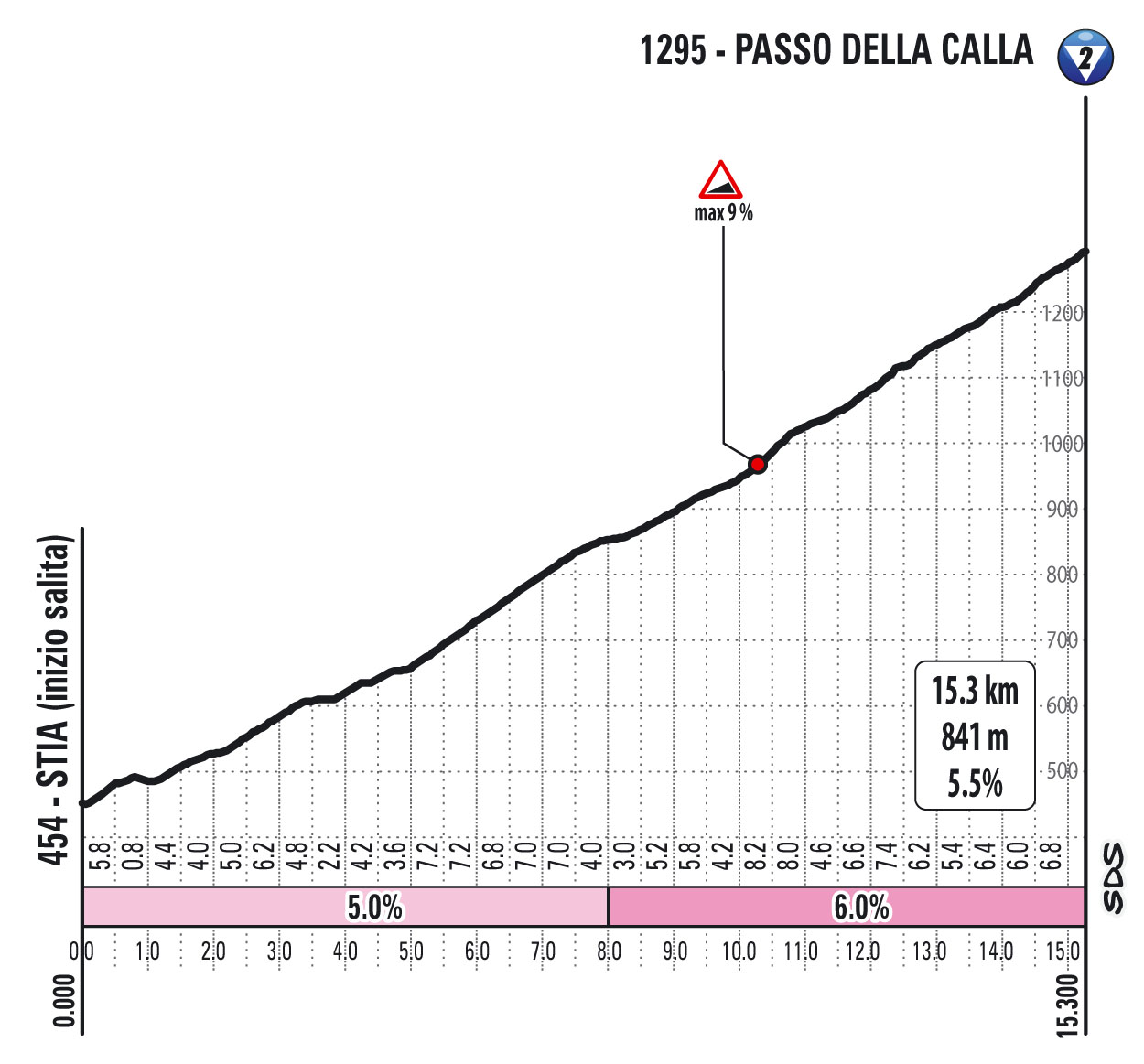
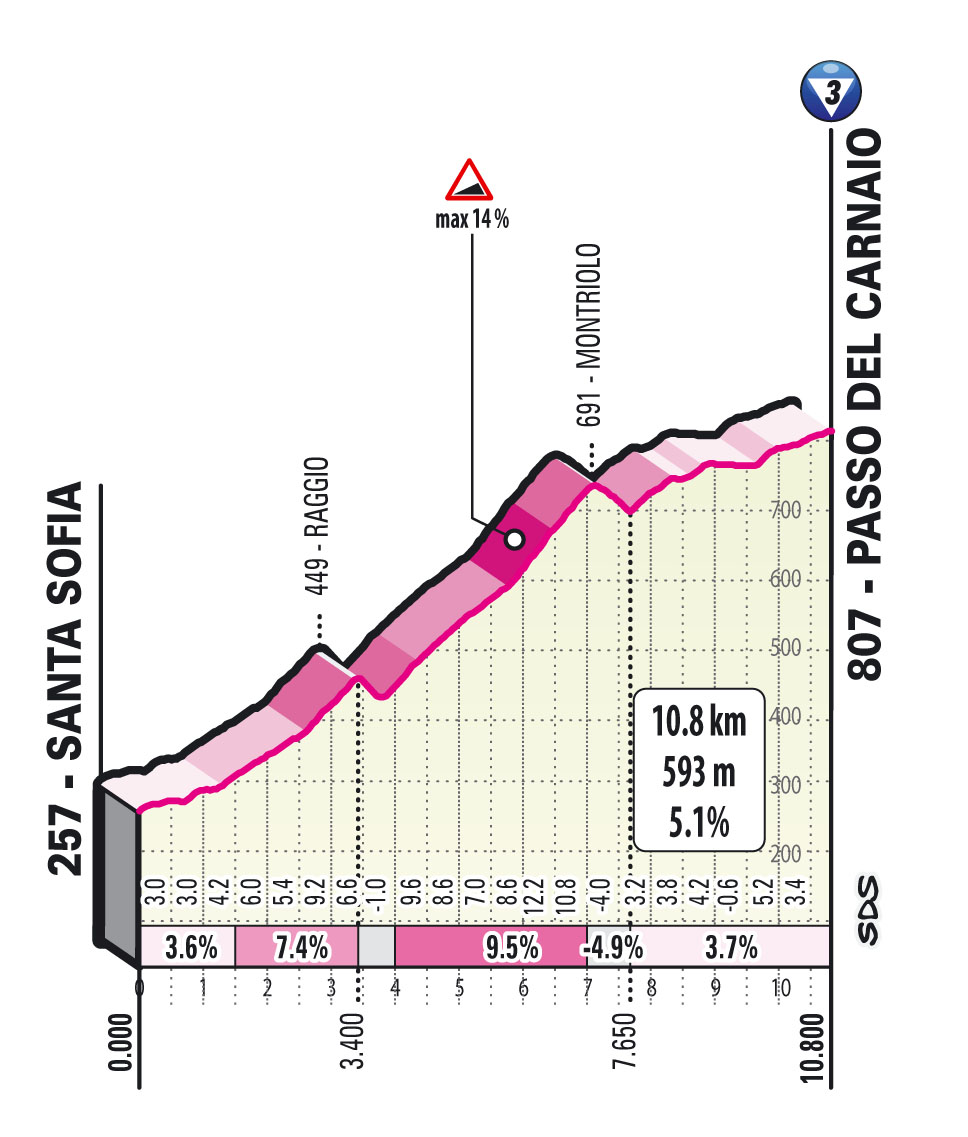
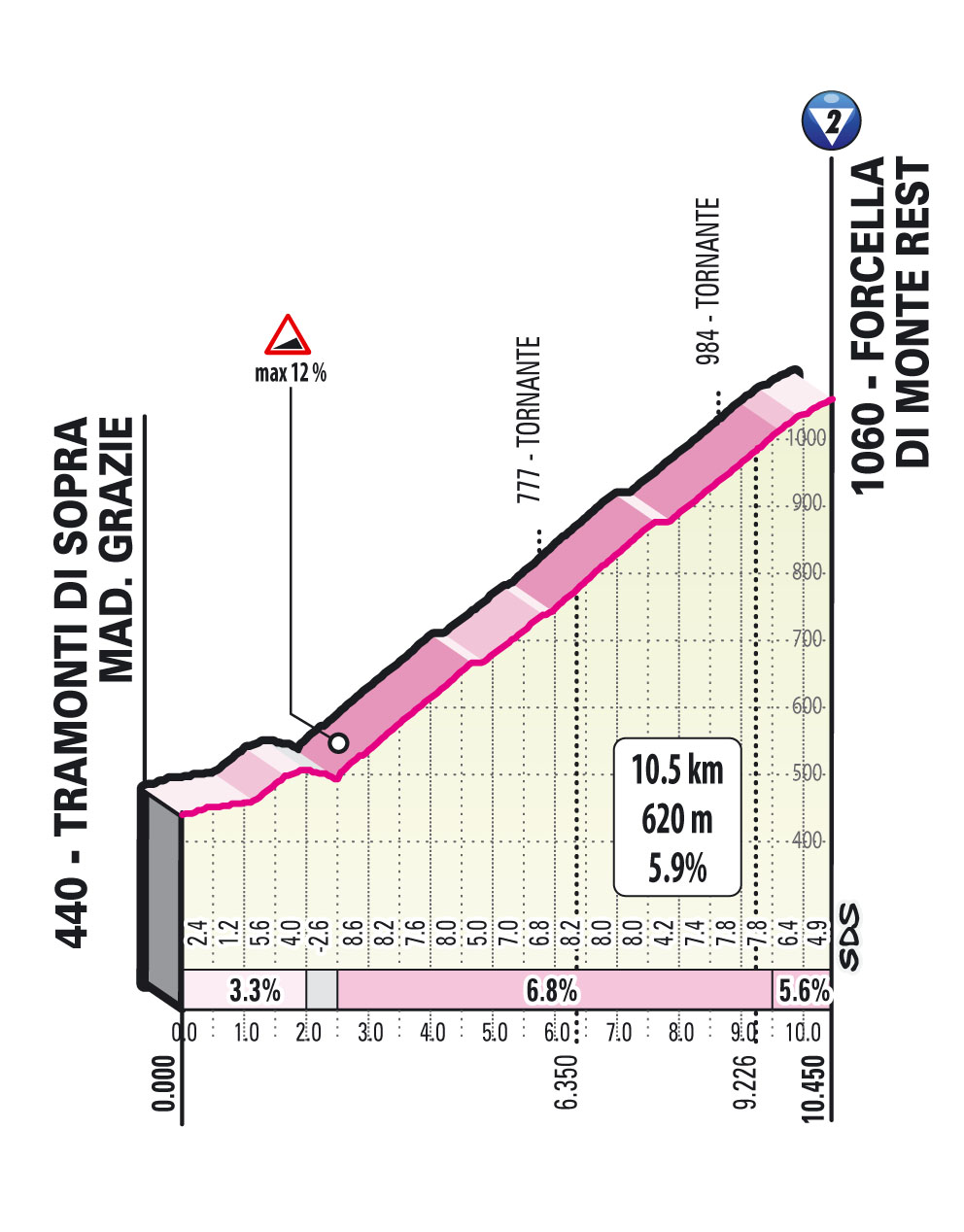
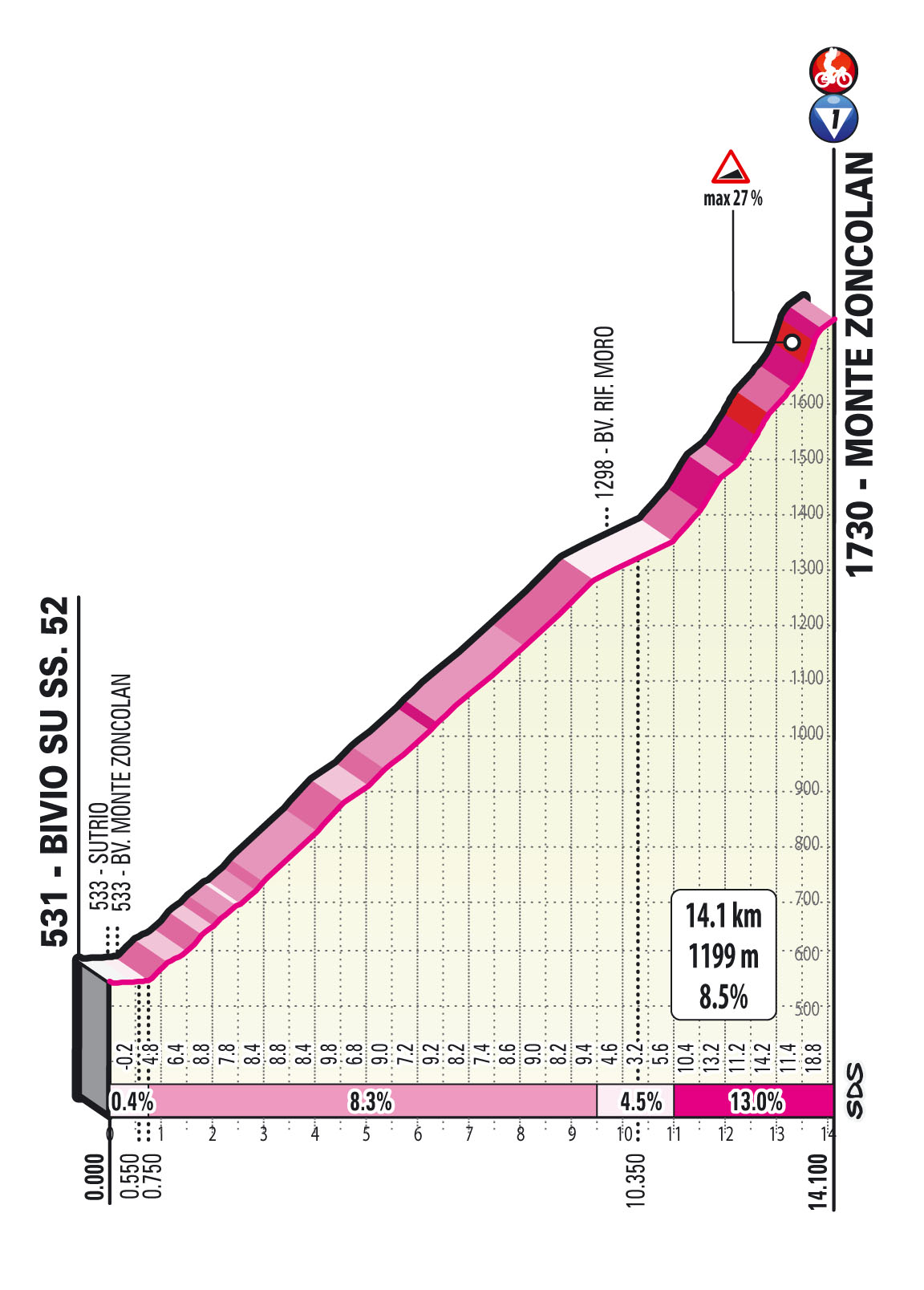
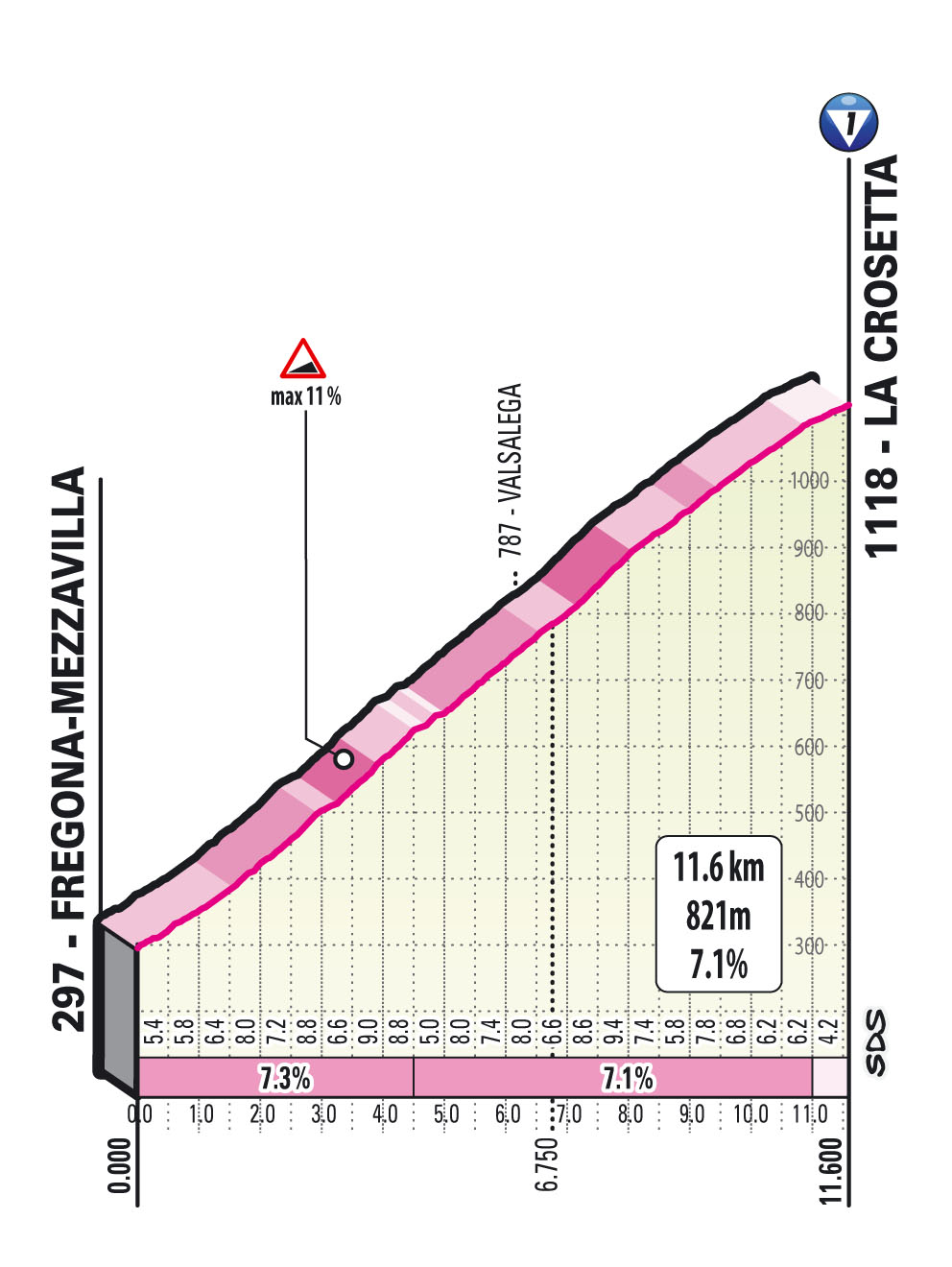
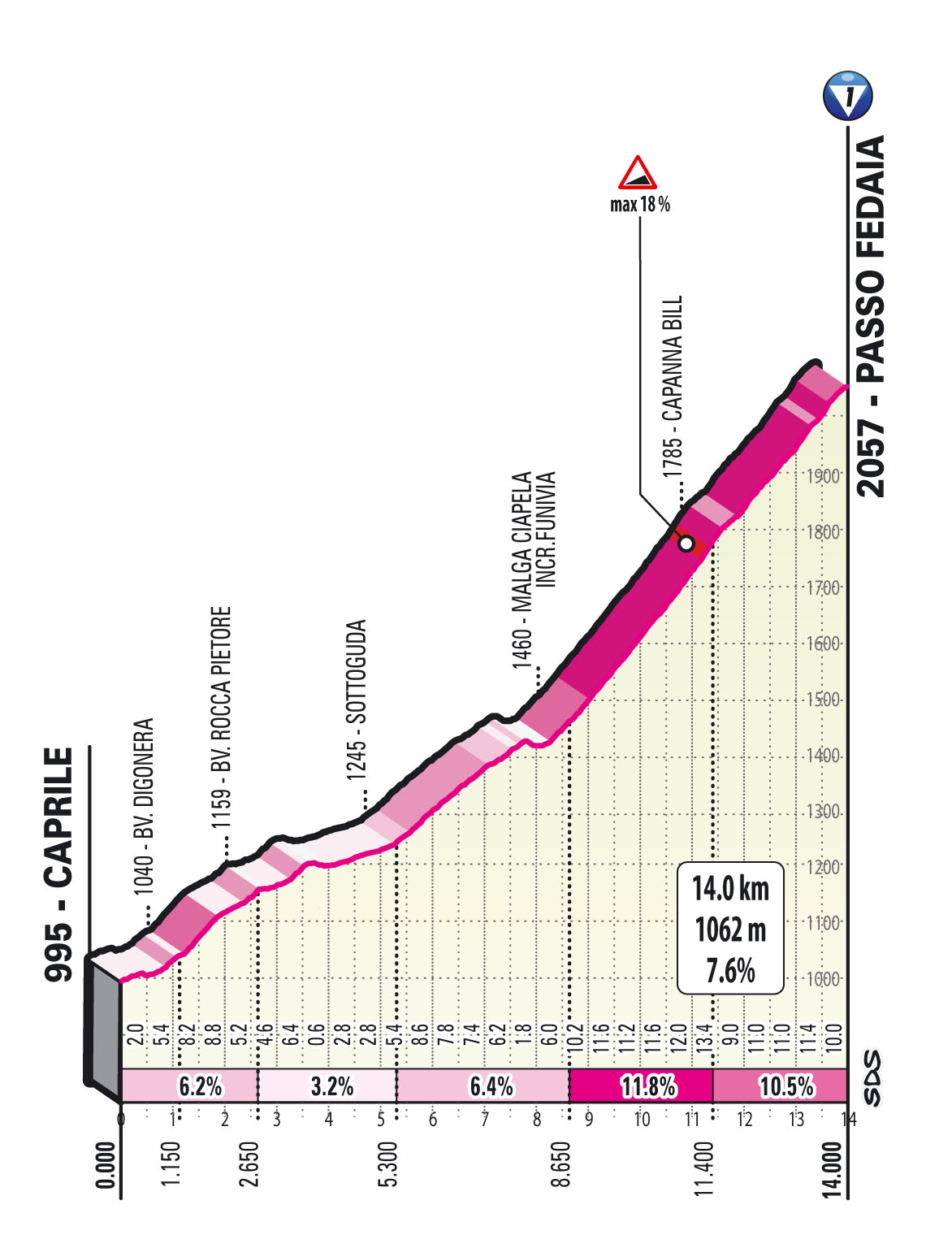
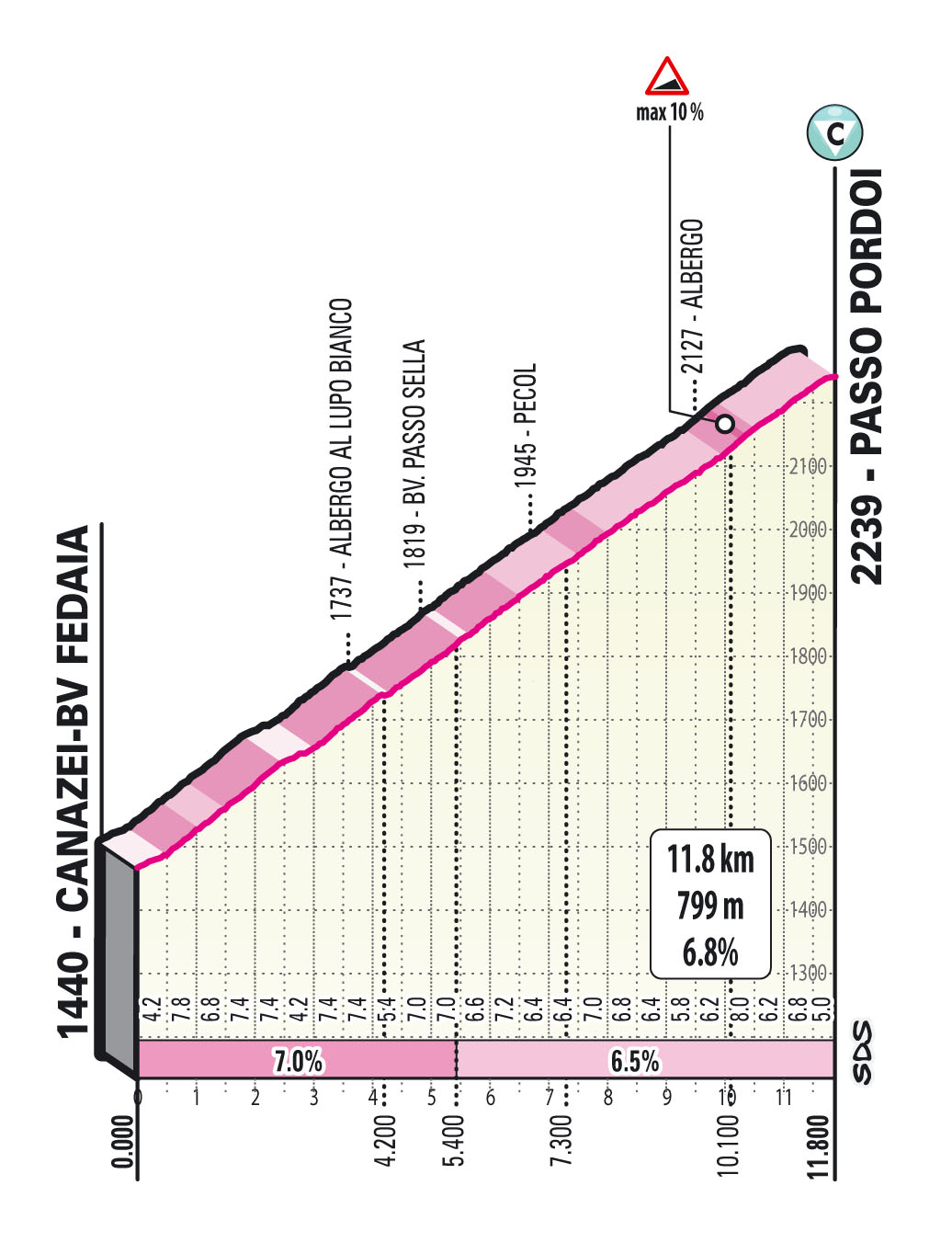
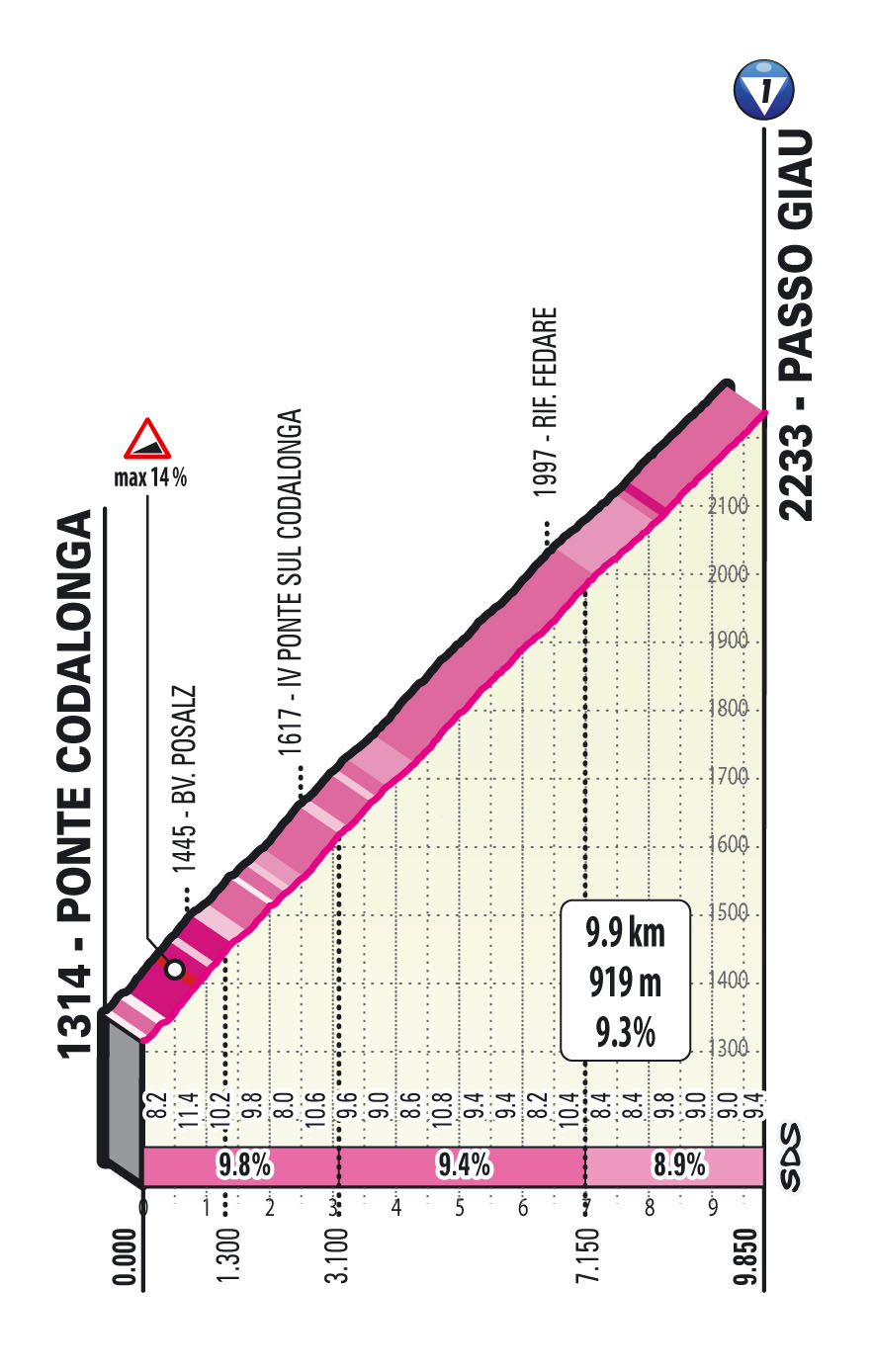
Stage 11 - Strade Bianche: After the first rest day, riders are thrown right back into the fray with a Strade Bianche-like stage 11 on Tuesday, May 19 to Montalcino that heads over four gravel sectors, two of which are part of the classified climb. The first approach of the Passo del Lume Spento climbs up through Castiglion del Bosco on a 13.5km gravel section containing both an intermediate sprint and a category 3 mountain prime before descending to a second intermediate sprint. The race then does a circuit that comes at the Passo del Lume Spento from the opposite direction with a 5km gravel sector before a paved climb that pitches up to 12 per cent before flattening ahead of the summit that comes with 3.8km to go.
Stage 12 - Four long climbs: Stage 11 is just an appetizer for the mountains to come in the second week, with four medium mountains on the Wednesday, May 20 stage 12. The Monte Morello (7.6km, average 6.6% maximum 19%) and the Passos Consuma, della Calla and Carnaio each hold their own challenge. The Consuma is 17.1km long, the Calla is 15.3km but neither is overly steep. The Carnaio, by contrast, is 10.8km but the middle 4km average 9.5 per cent and there is a significant stretch at 14 per cent and the top comes with 9.4km to go.
Stage 14 to Monte Zoncolan: The riders get one flat day of rest before hitting the first absolutely key stage of the Giro d'Italia to the top of Monte Zoncolan. It's a make-or-break day that starts off flat but gets progressively tougher until the brutal finale. The category 4 Castello di Caneva is a great place to start the early breakaway, the mid-stage Forcella Monte Rest with 58km to go is one for the chancers - at 10.5km and 5.9 per cent. The race will explode on the early slopes of the Zoncolan which begin rather reasonably, averaging 8.3 per cent with a nice respite 10km in before the torture begins. The final 3km average a crushing 13 per cent with pitches of 22, then 25 before a maximum 27 per cent (!!!) in the last 500 metres.
Stage 16 triple hump: After a brief foray into Slovenia, the Giro d'Italia heads into the Dolomites on Monday, May 24 with four major climbs on offer. The stage heads straight from Sacile up La Crosetta (11.6km, 7.1%) before settling in for that early breakaway to get a big lead. A major crux point of the second week comes in the final 100km of the massive 212km stage, with three high mountains: The Passo Fedaia (14km, 7.6%) is brutal in its second half with stretches of 18 per cent and averaging over 10. After that, there is still 83.9km and two more huge hills to go.
There is still 58.8km to go at Cima Coppi - the Passo Pordoi - the highest point of the 2021 Giro d'Italia. It's 11.8km long and not as steep as the Fedaia but steady and, hitting 10 per cent grades at over 2,000m in altitude will test the riders' lungs for sure. After being thoroughly exhausted, the peloton descends through an undulating valley before hitting the Passo Giau - another brute at 9.9km and 9.3 per cent average that goes back into the rarified air of the 2,200m range before dropping 17km to the finish.
Quality over quantity in the Alps
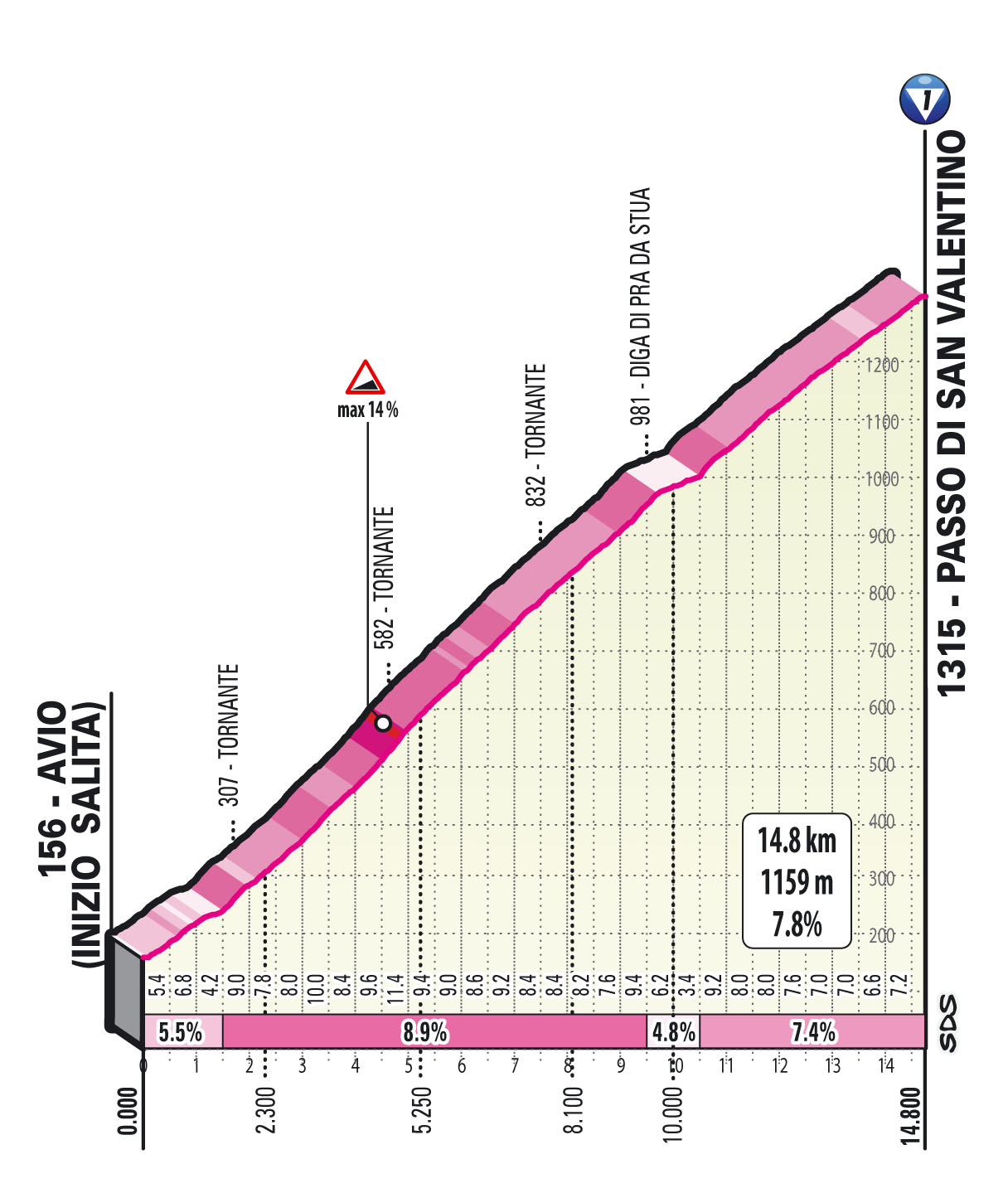
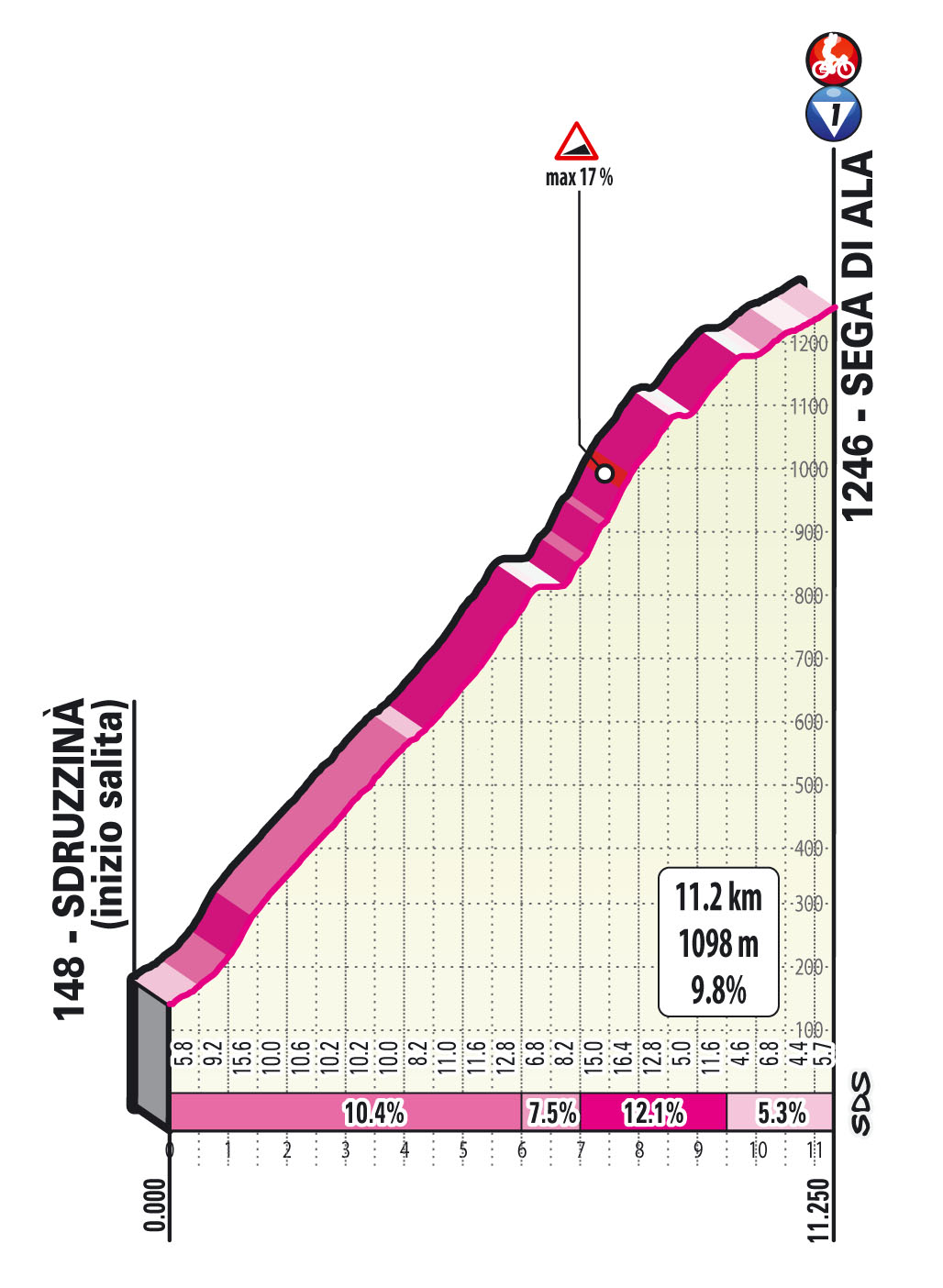
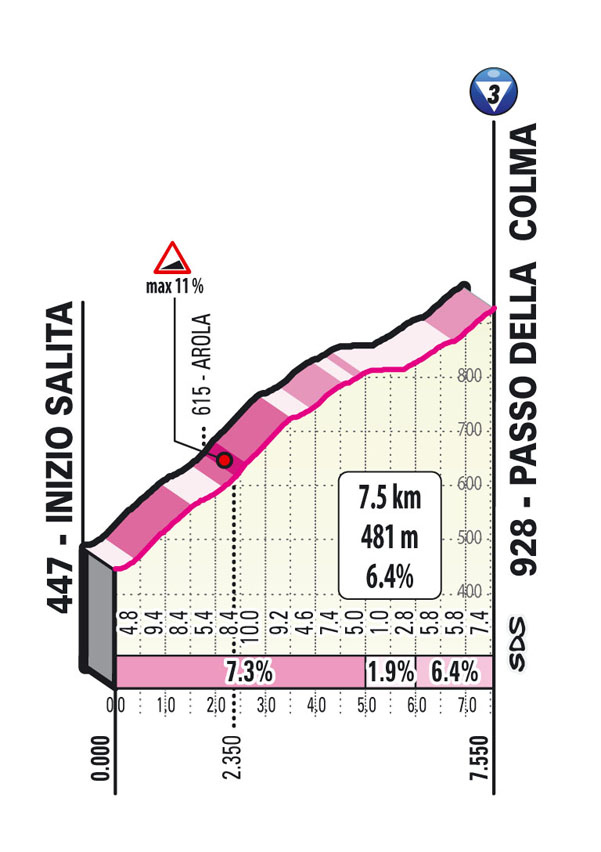
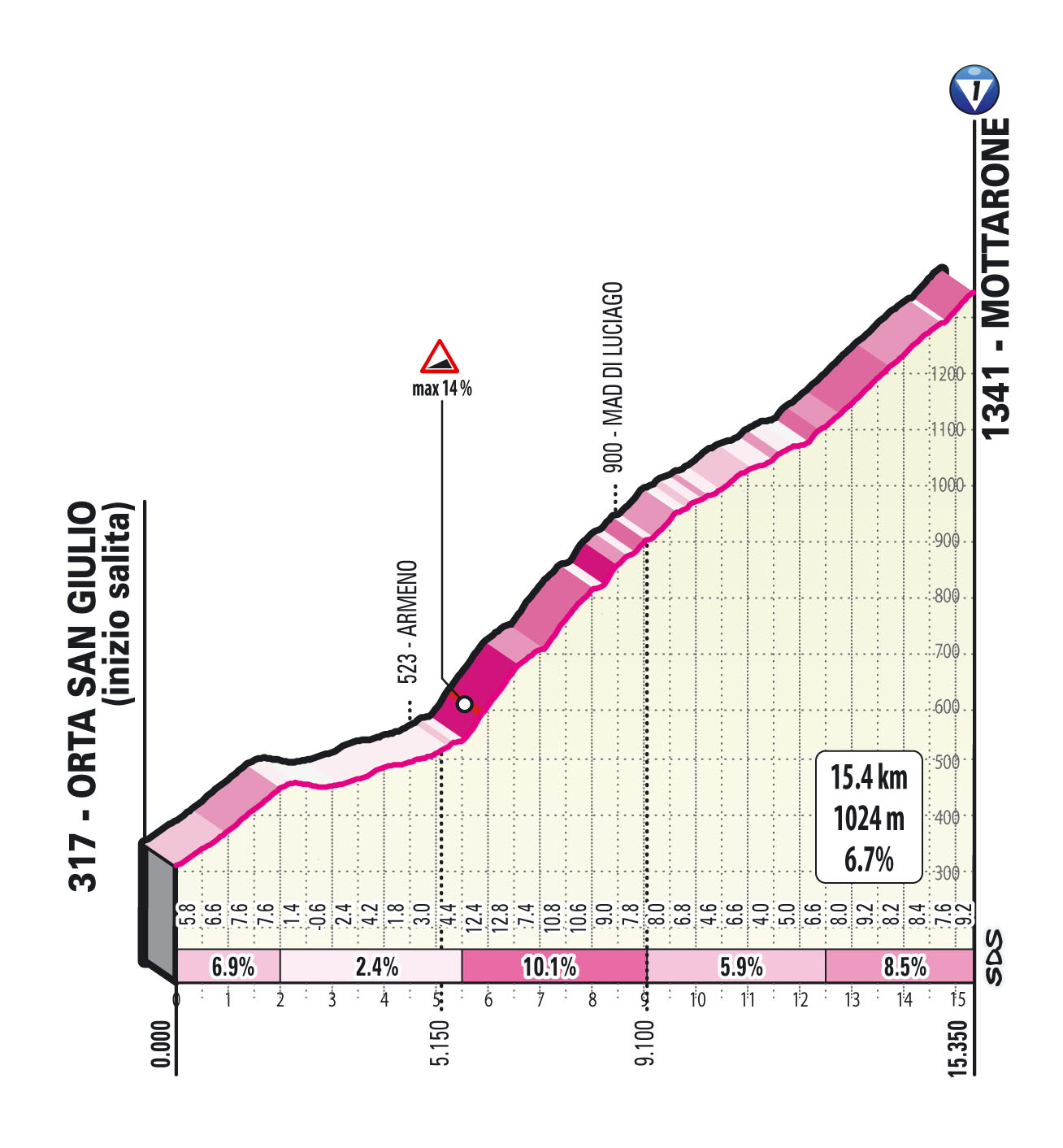
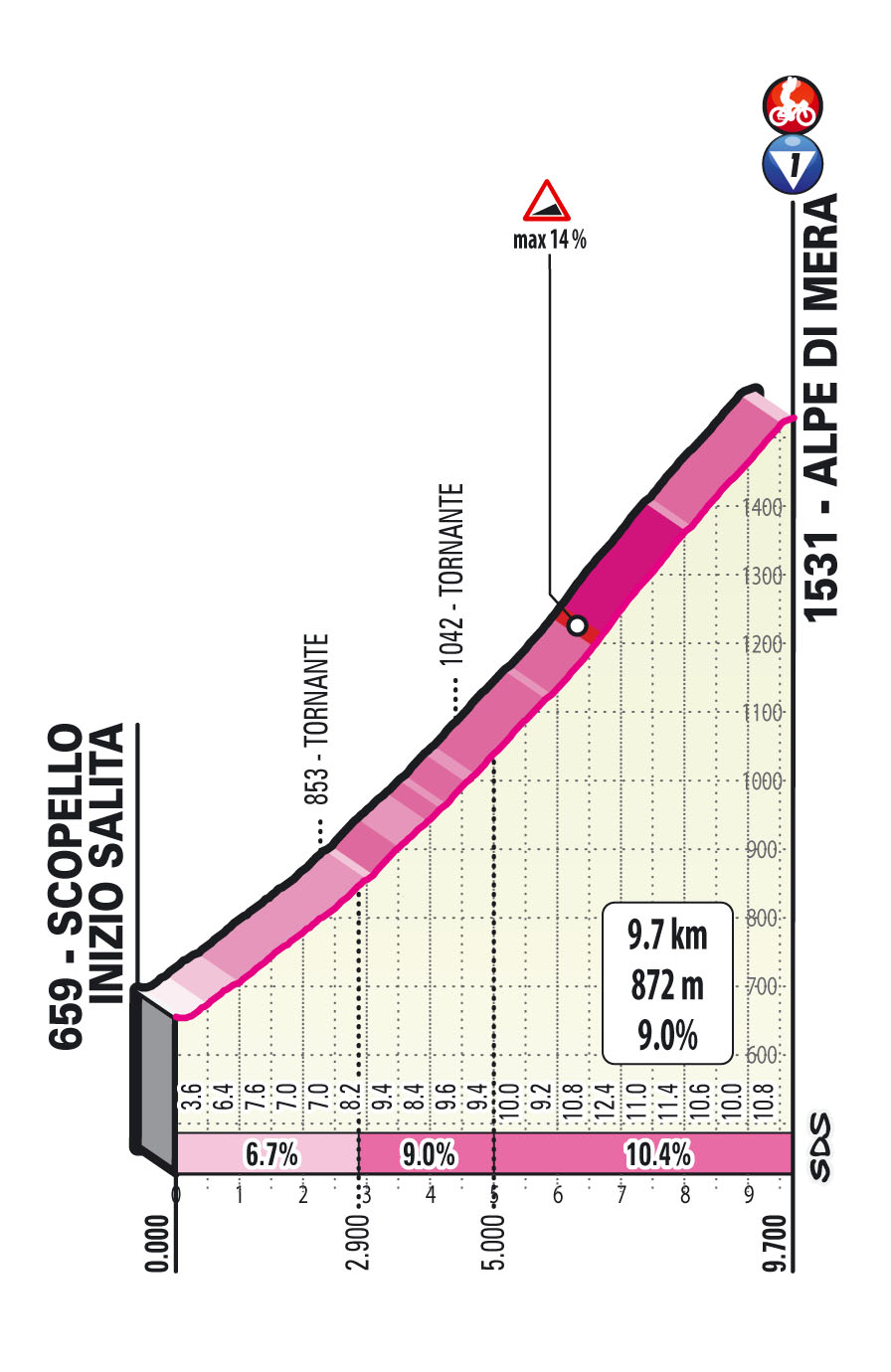
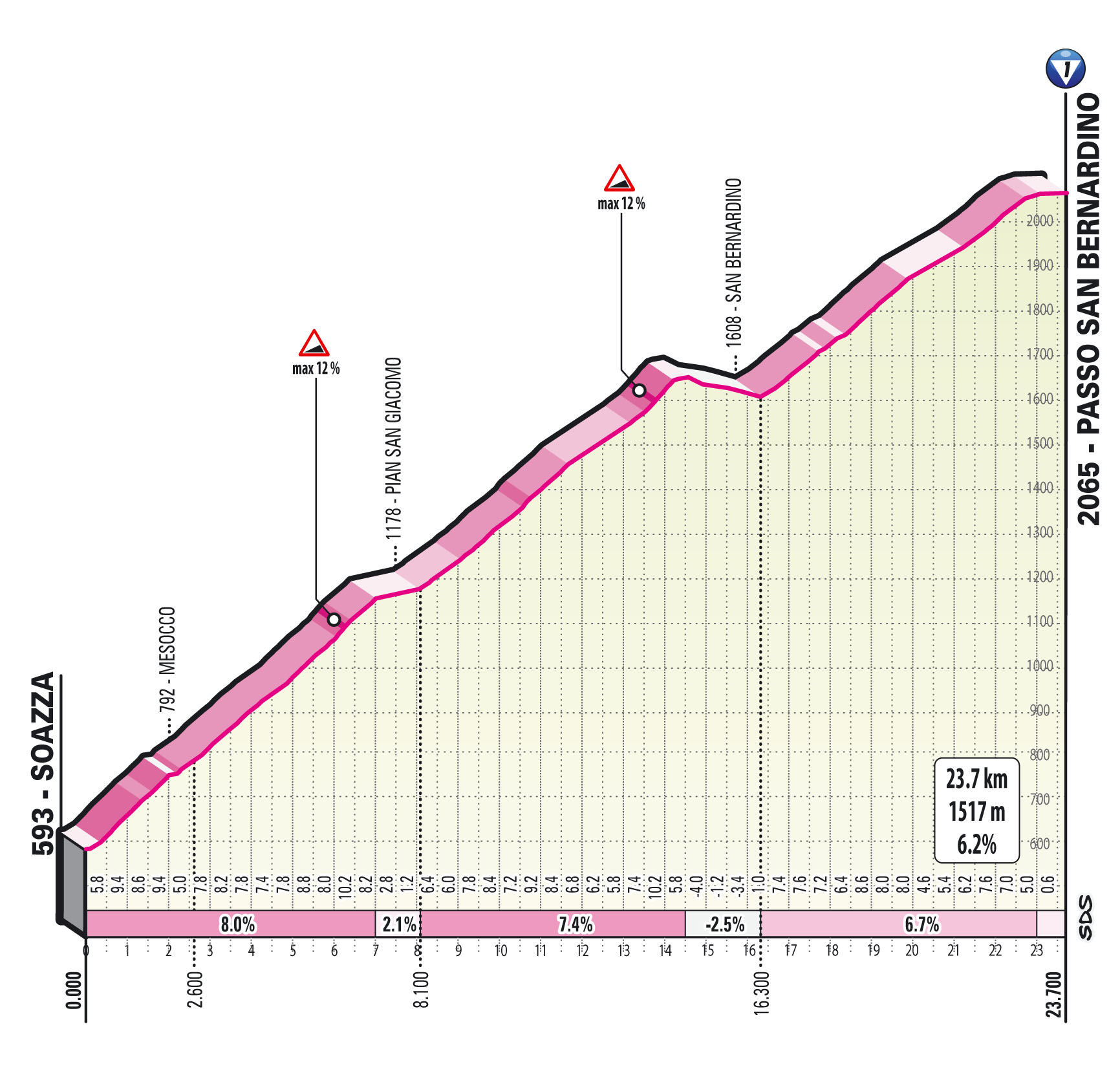
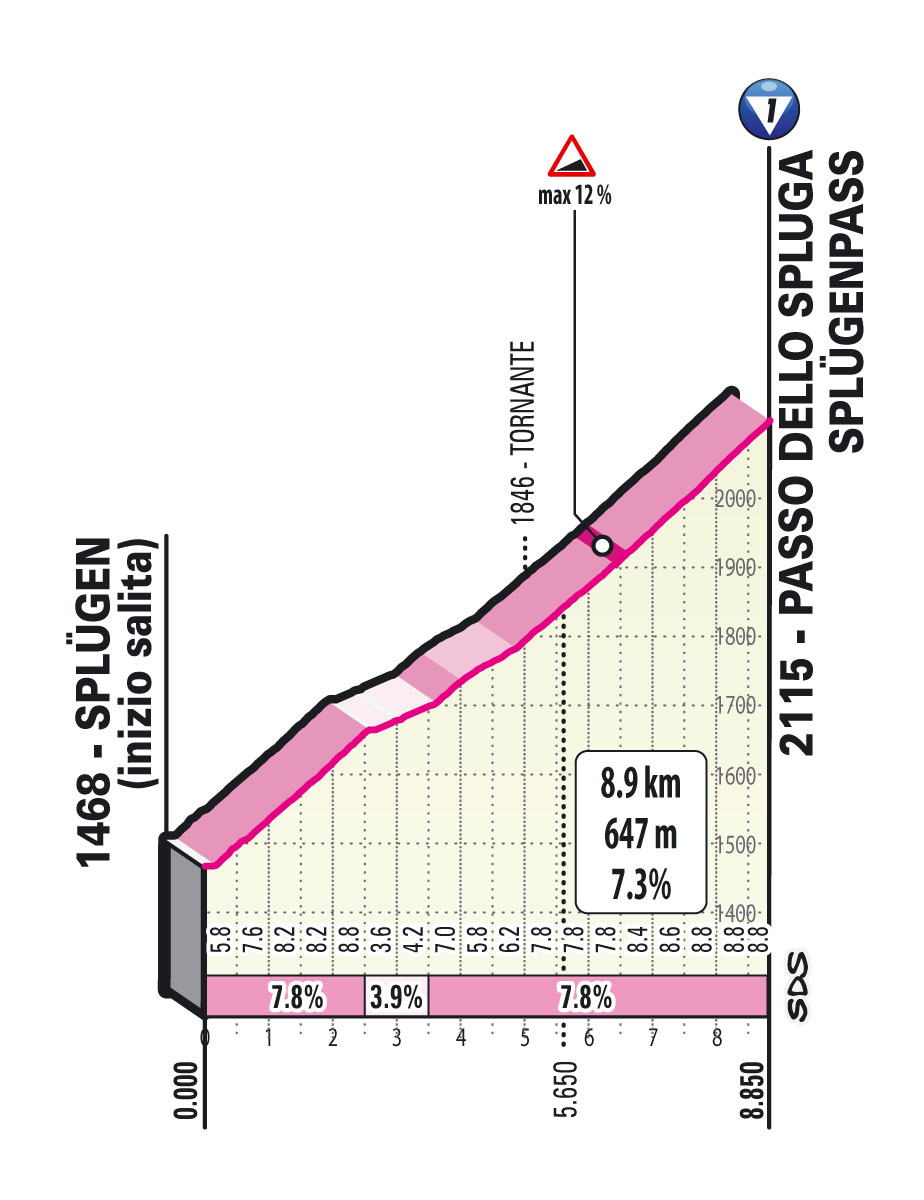
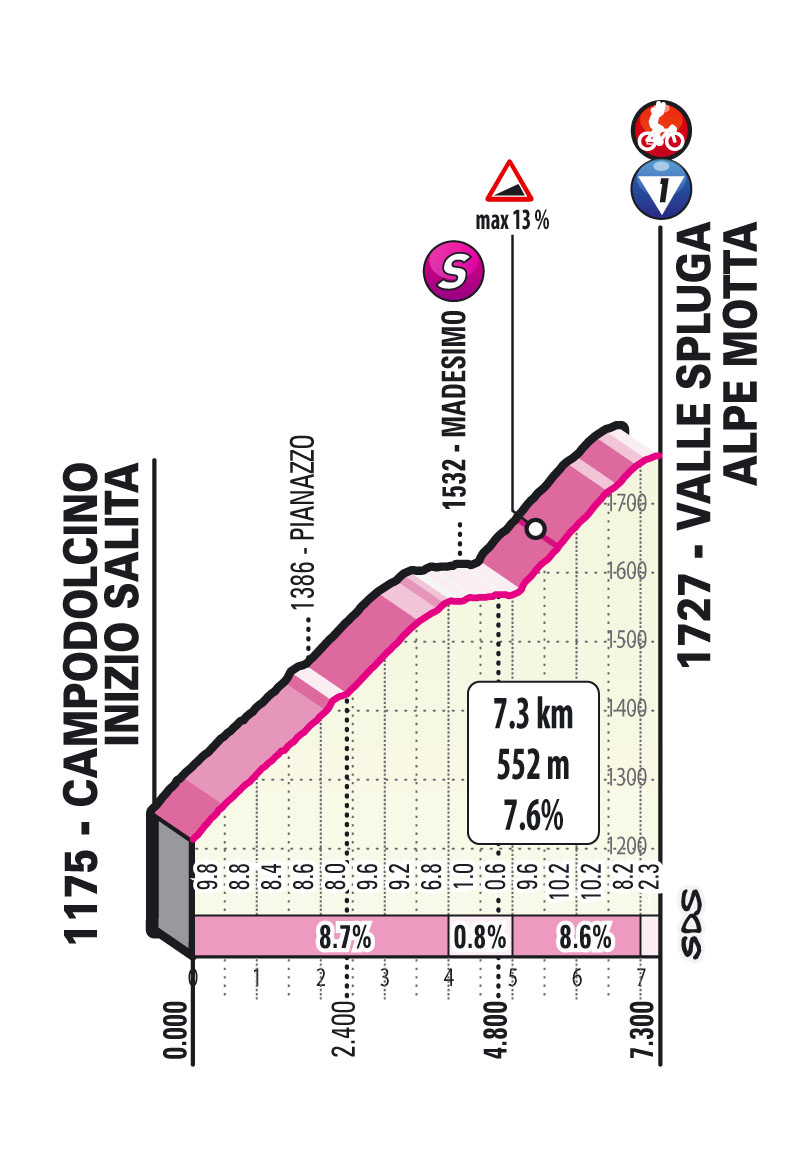
Stage 17 summit showdown: The Giro d'Italia resumes after the second rest day with more climbing and the race's fifth summit finish on Sega di Ala. The 193km stage starts with a mostly downhill run to the first category 3 climb at Sveseri, a flat run through the valley before the fireworks start at the Passo san Valentino. At 14.8km and an average 7.8 per cent, the climb is worst in the first half with a 14 per cent max grade. There's a flat section after 10km that's perfect for an attack and, especially with a fast descent to the base of the final climb. The Sega di Ala is another brute of a climb, kicking up fast and steeply - the first 6km average over 10 per cent before a brief easing for riders to catch a breath before tackling 2.5km at over 12 per cent and a maximum 17 per cent wall. There's another steep pitch with 2km to go before the flatter final kilometre.
Stage 19, 20 - back to back Alpine challenges: After a flat stage 18 with just one category 4 climb, the last major mountain tests come back to back on Friday, May 28 and Saturday, May 29 before the final time trial in Milan on Sunday.
Although coming early on stage 19, the Mottarone - last used in 2011 - is 15.4km of climbing with 4km of 10 per cent gradients before leveling off. It pitches up again near the top but most likely the GC men will save their matches here and at the category 3 Passo della Colma (7.5km at 6.4%) for the final assault at Alpe di Mera. The Mera is another leg-breaker at 9.7km and an overall average 9 per cent. The maximum grade is 14 per cent but the last 5km are all over 10 per cent, making for a bad day to struggle.
Stage 20 is the final push for the climbers and there will be no holding back on the 164km stage with three category 1 passes crammed into the second half of the stage. The first, the Passo San Bernardino, is the longest of the race at 23.7km and although it averages 6.7 per cent, the first 7km are steadily around 8 per cent with a pitch of 12 per cent. There's another steep stretch before the climb is interrupted by almost 2km of a shallow descent before more steady climbing to the top at 57.8km to go.
The shorter Passo della Spluga tops out at 29.1km to go (8.9km, 7.3%) but the real showdown will come on the last climb of the 2021 Giro d'Italia, the Alpe Motta where, in the 1965 Giro, Vittorio Adorni took one of the most memorable victories of his career while wearing the maglia rosa. The Motta is 7.3km long but the 7.6 per cent average is skewed by a flat kilometre halfway up. The first half is regularly above 8 per cent and the kilometre above 10 starting at 2km to go will be the last chance for any GC battle before the time trial.

Laura Weislo has been with Cyclingnews since 2006 after making a switch from a career in science. As Managing Editor, she coordinates coverage for North American events and global news. As former elite-level road racer who dabbled in cyclo-cross and track, Laura has a passion for all three disciplines. When not working she likes to go camping and explore lesser traveled roads, paths and gravel tracks. Laura specialises in covering doping, anti-doping, UCI governance and performing data analysis.